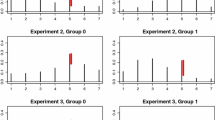Abstract
In this paper, mathematical modeling is treated as distinct from curve fitting. Considerations of psychological reality behind our data are emphasized, and criteria such as additivity in a model its natural generalization to a continuous response model, satisfaction of the unique maximum condition and orderliness of the modal points of the operating characteristics of the ordered polychotomous responses are proposed. Strengths and weaknesses of mathematical models for ordered polychotomous responses that include the normal ogive model, the logistic model, the acceleration model and the family of ordered polychotomous models developed from Bock’s nominal model are observed and discussed in terms of such criteria. It was concluded that it will be better to leave Bock’s model as a nominal model as he intended it to be, without expanding it to ordered polychotomous models.
Similar content being viewed by others
References
Birnbaum, A. (1968). Some latent trait models and their use in inferring an examinee’s ability, Contributed chapters in Lord, F.M. and Novick, M.R., Statistical theories of mental test-scores, Chapters 17–20, Reading, MA: Addison Wesley.
Bock, R.D. (1972). Estimating item parameters and latent ability when responses are scored in two or more nominal categories. Psychometrika, 37, 29–51.
Luce, R.D. (1959). Individual choice behavior, New York: Wiley.
Masters, G.N. (1982). A Rasch model for partial credit scoring. Psychometrika, 47, 149–174.
Muraki, E. (1992). A generalized partial credit model: application of an EM algorithm. Applied Psychological Measurement, 16, 159–176.
Samejima, F. (1969). Estimation of latent ability using a response pattern of graded scores. Psychometrika Monograph, No. 17.
Samejima, F. (1972). A general model for free response data. Psychometrika Monograph, No. 18.
Samejima, F. (1973a). Homogeneous case of the continuous response model. Psychometrika, 38, 203–219.
Samejima, F. (1973b). A comment on Birnbaum’s three-parameter logistic model in the latent trait theory, Psychometrika., 38, 221–233.
Samejima, R. (1979). A new family of models for the multiple-choice item. University of Tennessee, Knoxville, TN: Office of Naval Research Report, 79-4.
Samejima, F. (1993a). An approximation for the bias function of the maximum likelihood estimate of a latent variable for the general case where the item responses are discrete. Psychometrika, 58, 119–138.
Samejima, F. (1993b). The bias function of the maximum likelihood estimate of ability for the dichotomous response level. Psychometrika, 58, 195–209.
Samejima, F. (1995). Acceleration model in the heterogeneous case of the general graded response model. Psychometrika, 60, (to be published in the December issue).
Samejima, F. (in preparation). Virtues of asymmetric item characteristic curves.
Thissen, D. & Steinberg, L. (1986). A taxonomy of item response models. Psychometrika, 51, 567–577.
Author information
Authors and Affiliations
Corresponding author
About this article
Cite this article
Samejima, F. Evaluation of Mathematical Models for Ordered Polychotomous Responses. Behaviormetrika 23, 17–35 (1996). https://doi.org/10.2333/bhmk.23.17
Received:
Published:
Issue Date:
DOI: https://doi.org/10.2333/bhmk.23.17




